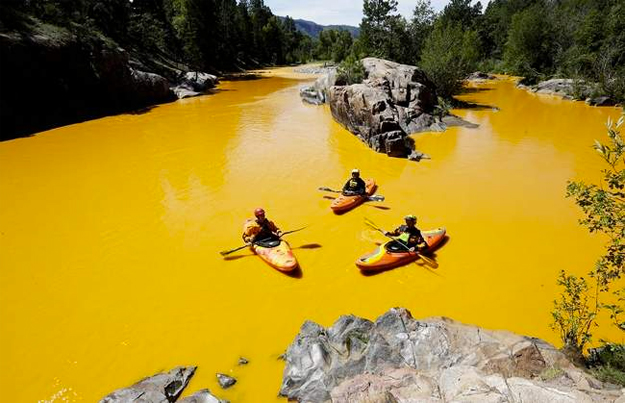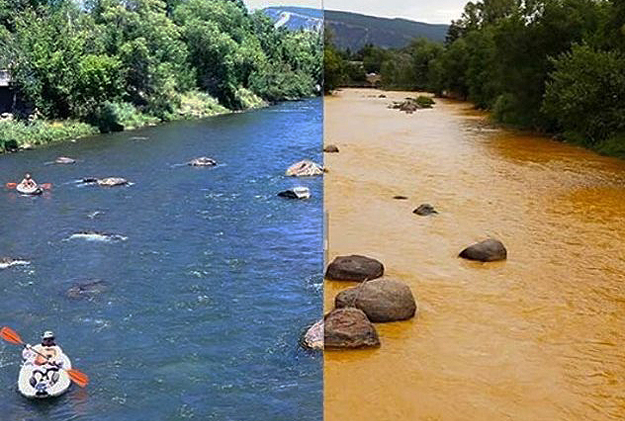
Kayakers Dan Steaves, Eric Parker and David Farkas found themselves in the Animas River north of Durango, Colorado on Thursday, the same day an EPA team allowed contaminated mine waste from the Gold King Mine above Silverton to spill into the river. Photo Jerry McBride/Durango Herald. Used with permission. For excellent local coverage of the Gold King Mine spill, follow The Durango Herald here.
LAST WEDNESDAY, a team working for EPA Region 8 caused a spill of 3 million gallons of yellow sludge contaminated with toxic metals from the Gold King Mine north of Silverton, Colorado into Cement Creek, a tributary to the Animas River. By Sunday, New Mexico was on high alert as the spill made its way to the state’s border, headed for the San Juan River.
The EPA team had been attempting to remediate continuing leaks emanating from the collapsed entry of the long abandoned mine. But it underestimated the amount and pressure of the backed-up wastewater and everything gave way. The agency’s website explains:
The plan was to excavate the loose material that had collapsed into the cave entry back to the timbering. During the excavation, the loose material gave way, opening the adit (mine tunnel) and spilling the water stored behind the collapsed material into Cement Creek, a tributary of the Animas River.

The Animas River before and after. Image via The Durango Herald. Used with permission.
For decades, the mine, closed in 1923, has been a persistent environmental threat and source of pollution. Silverton citizens firecely resist a Superfund designation, fearing the toxic stigma, according to reporting by The Durango Herald. The latest spill could change local opinion. It has endangered water supplies, affected the Navajo nation, businesses, farmers and ranchers, and halted lucrative recreational activities. EPA has yet to determine the effects on fish and other organisms. Governor John Hickenlooper declared a state of disaster on Sunday. The Animas has been closed to human use until at least August 17.
EPA stated on its website that it “is committed to taking responsibility for the discharge and impacts to affected communities.” But how far is the agency willing to go? Toxic metals such as arsenic and cadmium tend to settle to a river bottom and remain a long-term threat.
A recent case brought by EPA Region 8 against Cottonwood Creek Inc., is partly instructive. EPA collected a $170,000 settlement for the company’s failure to provide spill prevention at its Bonanza Station in Big Horn County, Wyoming. EPA’s news release stated:
These plans are the first line of defense for preventing oil discharges and providing immediate containment measures when an oil discharge does occur. . . This settlement underscores the importance of EPA’s oil spill prevention requirements in safeguarding our rivers and streams.
Though the case involved oil rather than mining wastes, and the amount of the settlement was meager considering an alleged discharge of 162 barrels of crude oil into a tributary of the Nowood River, the urgency with which EPA regards spill prevention is evident.
Interestingly, the settled penalty in the Cottonwood case will be deposited in the federal Oil Spill Liability Trust Fund. A federally funded trust specific to the Animas River — at a far greater amount than the Cottonwood case — would seem in order, given EPA’s culpability, its own enforcement policy, and the recent reaction by United States Senator Michael Bennet, D-Colo:
We are going to hold the EPA accountable to make sure that they meet the highest standard of response, and if that standard sets an example for other actors, that will be a good thing.
We have asked EPA Region 8 to comment and await its reply.
For regular updates from EPA follow this link.
For EPA monitoring results, follow this link.
For local and regional coverage of the spill and its aftermath, follow The Durango Herald.










Trackbacks/Pingbacks